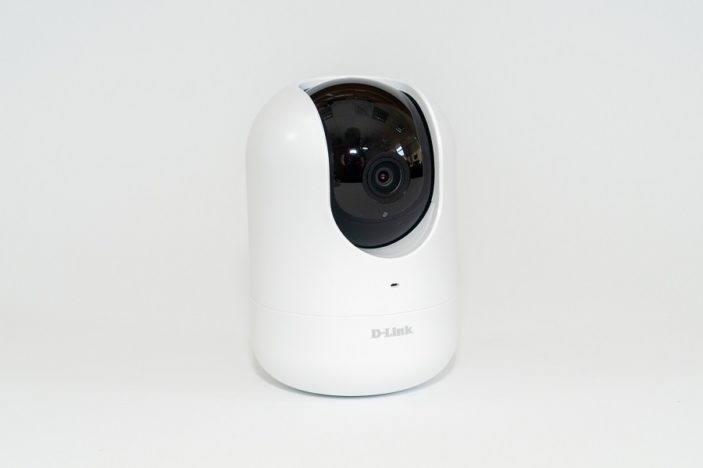
An indoor camera that is able to rotate and tilt for a full 360-degree view is of unquestionable value when it comes to smart home tech. Lucky, then, that the ever-reliable D-Link launched one towards the end of last year as part of a small addition to their already solid line-up of smart security tech. Though the brand may be best known, and experienced, through their advanced Wi-Fi routers and mesh systems, its clear the company puts up a solid front when it comes to competing with the likes of Amazon, Arlo, and Google for a slice of the increasingly stacked security market.
If you’ve been reading tech reviews on the AU review, especially in the past 12 months, you’d know that smart home tech is a big interest point for us. And security plays into this in a big way. More people are seeing the utility in having more than a few of these cameras around the house or office so remote monitoring is a seamless and easy experience.
The D-Link FHD Pac & Tilt Wi-Fi Camera cuts through with confidence, primarily focused n the 340-degree and a 100-degree tilt mechanism. The main reason to invest in one is being able to track movement around space in clear, crisp 1080p. That’s infinitely better than a static camera,
D-Link A/NZ has launched two new mydlink cameras, the DCS-8526LH Full HD Pan/Tilt Pro Wi-Fi Camera and the DCS-8630LH Full HD Outdoor Wi-Fi Spotlight Camera. Both feature edge-based person detection with AI technology, allowing for more intelligent surveillance capabilities and personal automation options for every smart home. The DCS-8630LH also has an integrated spotlight to literally help you see in the dark.
Design
This isn’t wire-free, which leaves a lot of room for improvement of which I have no doubt we’ll see this year. You need a power point nearby to plug in the micro-USB charger to the round base. The base itself means the camera unfortunately cannot be wall-mounted, although it can be placed on a ceiling and is smart enough to invert the feed based on positioning.
Your best approach is always going to be standing the camera on its base, so be aware of that when picking out where to place the camera. A bookshelf is probably best, or a counter if space isn’t an issue.
Although this doesn’t help the rather outdated aesthetic, which is quite unattractive when compared to slicker, more minimally designed competitors. For fans of design-forward technology, this camera might be a problem.
Performance
Once you get it connected to the 2.4Ghz band, its safe to expect the signal to remain solid throughout. Although proximity to your router does matter a great deal, and I’ve found that the further I move the camera away the drop-offs are much more noticeable. This is of course to be expected with just about any device, but the weakness here is quite glaring.
Connecting via Ethernet is infinitely going to be the better option and its a great comment in favour of D-Link that they at least included options for both. There’s very little lag if you choose this option.
Chances are if you’ve already bought into D-Link’s ecosystem then you’re going to have a mesh system or at least a strong router. This ups performance significantly, although lag is an issue if you’re relying on W-Fi no matter what. 2-way audio lag is the most obviously one, bumping as high as 5 seconds depending on signal.
Fitted with a large 2MP Sony CMOS sensor, video quality is quite decent, but again this relies a lot of signal strength. Move the camera away far enough from the router and you can forget about 1080p, rather contending with something much closer to 720p – meaning slightly blurred faces and horrible night performance. Various software has been included to help, including automatic white balance, digital noise reduction, and back light compensation – but even this can’t make up for a poor signal.
AI is quite strong, with the camera quite accurate when it comes to distinguishing between human emotion and more negligible ones like an insect. I don’t currently have any pets in my house, but do assume that this won’t flood you with notifications even time your cat struts by.
A definite benefit of going with this indoor camera as opposed to similar products from Amazon is, much like Arlo, that D-Link is agnostic between the two major voice assistants. You can use either Google Assistant or Alexa here, and the mic obviously picks voice commands up quite well and from afar.
128-bit encryption means that privacy is of no concern, but of course anyone who is paranoid about that kind of issue is always going to be harder to convince. At least D-Link have included edged-based tech, which also processes information on the device locally so it isn’t sending video a cloud during processing.
Verdict
D-Link is one of the easiest and most user-friendly brands when it comes to setting up routers and mesh systems, and I’m happy to report that their cameras are no exception. The officially dlink app is well-planned, uncluttered and easy-to-use, which is important if you’re going to be dealing with this remotely and want to monitor the house at personal whim.
There is a noticeable weakness if you aren’t positioning the camera near a router though, but as long as you’re doing that I have no hesitation when it comes to recommending this great, affordable camera for anyone looking for something a bit more affordable than more high-end competitors – especially for anyone already in the D-Link ecosystem.
![]()
![]()
![]()
![]()
![]()
THREE STARS(OUT OF FIVE)
Highlights: Very easy set up, 360-degree scope, accurate motion tracking and doesn’t overwhelm with vague motion events.
Lowlights: Needs to be fairly close to a router; very weak signal when not placed strategically; audio lag; a bit ugly.
Manufacturer: D-Link
Price: $179
Available: Now
